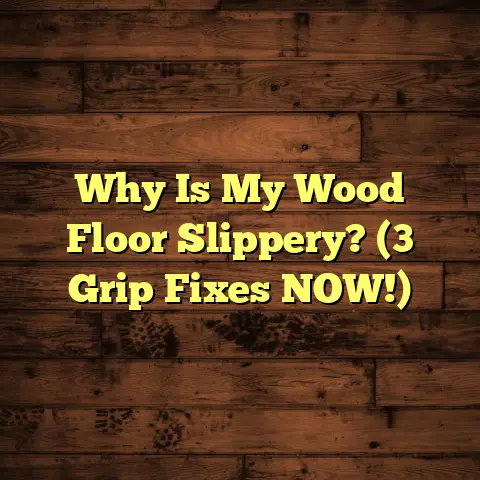Refinishing Wood Floors: Hard? (2 Day Pro Guide!)
Specifically, those gorgeous wood floors you’ve been dreaming of.
I’m talking about those floors that make a statement, the ones that scream style and personality.
Have you noticed the trend? People are going bold!
Think deep, rich stains, unique patterns, and finishes that POP.
But here’s the thing: Often, those stunning floors are hiding under layers of old varnish and wear.
That’s where refinishing comes in.
Now, you might be asking: “Is refinishing wood floors hard?”
Well, I’m here to tell you that while it’s definitely a project, it’s absolutely manageable.
With the right guidance (that’s me!), you can totally transform your home.
So, buckle up, because I’m about to give you the inside scoop on refinishing like a pro.
Section 1: Understanding Wood Floors
Okay, let’s get down to basics.
First, you need to know what kind of wood you’re working with.
Think of it like diagnosing a car before you start wrenching – crucial stuff!
There are a few main types:
-
Solid Hardwood: This is the real deal. Think oak, maple, hickory. It’s one solid piece of wood, super durable, and can be refinished multiple times.
-
Engineered Wood: This has a thin layer of real wood (the veneer) over a plywood core. It’s more stable in humid environments, but you can usually only refinish it once or twice, depending on the thickness of that veneer.
-
Laminate: This looks like wood, but it’s actually a photographic image on top of a composite material. You cannot refinish this.
-
Parquet: This involves small pieces of wood arranged in geometric patterns.
It can be refinished, but it’s trickier due to the intricate design.
So, why wood floors in the first place?
Well, they’re beautiful, obviously.
But they’re also incredibly durable.
I’ve seen hardwood floors last for generations!
Plus, they add value to your home. According to the National Association of Realtors, hardwood floors can increase a home’s resale value by as much as 2.5%.
And of course, there’s the potential for refinishing.
That’s where you can really unleash your inner designer.
I’ve seen homeowners go wild with bold designs.
We’re talking ebony stains for a dramatic look, Herringbone patterns for a classic feel, or even custom stencils for a truly unique floor.
Why do floors need refinishing?
Life happens! Scratches from pets, dents from furniture, fading from sunlight… it all takes a toll.
Plus, sometimes you just want a change!
Maybe you’re tired of that honey oak and want something more modern.
Whatever the reason, refinishing is a fantastic way to breathe new life into your home.
Section 2: Preparing for the Refinishing Process
Alright, preparation is KEY.
I cannot stress this enough.
It’s like prepping a canvas before you paint.
If you skip this step, you’re setting yourself up for a headache later.
First, assess the damage.
Are there deep gouges?
Is the finish completely worn away?
This will help you determine how much sanding you need to do.
Gather your supplies. Here’s what you’ll need:
-
Floor Sander: You can rent these from most home improvement stores. Get a drum sander for the main areas and an edge sander for along the walls.
-
Sandpaper: You’ll need a variety of grits, from coarse (36-grit) to fine (120-grit), depending on the condition of your floors.
-
Stain: Pick your poison! Gel stains are great for even coverage.
Remember those bold designs we talked about? Now’s your chance to experiment!
-
Finish: Polyurethane is a popular choice for its durability. You can choose oil-based (which gives a warmer tone) or water-based (which is more eco-friendly and dries faster).
-
Applicators: Brushes, rollers, and stain pads – choose what you’re most comfortable with.
-
Safety Gear: Dust mask, safety glasses, earplugs. Trust me, you’ll want these!
-
Vacuum and Tack Cloth: For cleaning up dust.
-
Painter’s Tape: To protect baseboards and trim.
Now, let’s talk timeline.
I recommend setting aside a full weekend for this project.
Day 1 will be sanding and staining, and Day 2 will be sealing and finishing.
Before you even think about sanding, you need to clear the room completely.
Remove all furniture, rugs, and curtains.
Cover any doorways or vents to prevent dust from spreading to other parts of the house.
This is where that painter’s tape comes in handy.
Protect those baseboards!
And remember, safety first!
Make sure you have proper ventilation.
Open windows and use fans to circulate air.
Now, about those bold design choices…
This is where you can really get creative.
Consider the style of your home and your personal taste.
Darker stains can add a touch of elegance and drama, while lighter stains can create a more casual, airy feel.
Matte finishes are trending right now, giving floors a more natural look.
Don’t be afraid to experiment!
You can even test out different stain colors on a small, inconspicuous area of the floor before committing to the whole thing.
Section 3: The Refinishing Process
Okay, the moment of truth!
Let’s break down the refinishing process into detailed, step-by-step instructions.
I’m going to walk you through each stage over two days.
Day 1: Sanding and Staining
Step 1: Sanding
This is the most important (and most labor-intensive) part of the process.
The goal is to remove the old finish and create a smooth, even surface for the stain to adhere to.
Start with a coarse grit sandpaper (36-grit or 40-grit) to remove the bulk of the old finish.
Work in the direction of the wood grain, overlapping each pass slightly.
Keep the sander moving at a steady pace to avoid creating dips or gouges.
Once you’ve sanded the entire floor with the coarse grit, switch to a medium grit (60-grit or 80-grit) and repeat the process.
This will smooth out any scratches left by the coarse grit.
Finally, finish with a fine grit sandpaper (100-grit or 120-grit) to create a super-smooth surface.
Don’t forget to use the edge sander to get those hard-to-reach areas along the walls and in corners.
Addressing Uneven Areas
If you have areas that are particularly uneven or damaged, you may need to spend more time sanding in those spots.
You can also use a hand scraper to remove stubborn spots of old finish.
Step 2: Cleaning
Once you’ve finished sanding, it’s time to clean up the dust.
This is crucial! Any dust left on the floor will interfere with the stain and finish.
Start by vacuuming the entire floor thoroughly.
Then, use a tack cloth to wipe down the floor.
A tack cloth is a sticky cloth that picks up any remaining dust particles.
Step 3: Staining
Now for the fun part! Applying the stain.
Before you start, make sure you’re wearing gloves and eye protection.
Open a can of stain in a well ventilated area.
Stir the stain thoroughly to ensure that the pigments are evenly distributed.
Using a brush, roller, or stain pad, apply the stain evenly to the floor, working in the direction of the wood grain.
Don’t apply too much stain at once.
It’s better to apply thin, even coats than one thick coat.
Allow the stain to sit on the floor for the amount of time recommended by the manufacturer.
The longer you leave the stain on, the darker the color will be.
Once the stain has sat for the desired amount of time, use a clean rag to wipe off any excess stain.
This will help prevent the stain from becoming blotchy.
Allow the stain to dry completely before moving on to the next step.
This could take anywhere from 4 to 24 hours, depending on the type of stain you’re using.
Day 2: Sealing and Finishing
Step 4: Sealing
Some people skip this step, but I highly recommend it.
Sealing the floor helps to protect it from moisture and wear.
It also helps the finish adhere better.
Apply a thin, even coat of sealer to the floor using a brush or roller.
Allow the sealer to dry completely before moving on to the next step.
This could take anywhere from 2 to 4 hours, depending on the type of sealer you’re using.
Step 5: Finishing
Finally, it’s time to apply the finish.
This is what will give your floors their shine and protect them from scratches and wear.
Polyurethane is a popular choice for its durability.
You can choose oil-based or water-based polyurethane.
Oil-based polyurethane is more durable, but it takes longer to dry and has a stronger odor.
Water-based polyurethane is more eco-friendly and dries faster, but it’s not quite as durable.
Apply a thin, even coat of finish to the floor using a brush or roller.
Work in the direction of the wood grain, overlapping each pass slightly.
Allow the finish to dry completely before applying the next coat.
I recommend applying at least two coats of finish, and preferably three.
This will give your floors the best protection.
Allow the final coat of finish to dry completely before walking on the floor.
This could take anywhere from 24 to 72 hours, depending on the type of finish you’re using.
Tips for Applying Finish
-
Avoid Bubbles: To prevent bubbles from forming in the finish, use a high-quality applicator and avoid shaking the can of finish.
-
Avoid Streaks: To prevent streaks, apply the finish in thin, even coats and work in the direction of the wood grain.
-
Ensure Even Coverage: To ensure even coverage, overlap each pass slightly and avoid applying too much finish at once.
Post-Finishing Care
Once the finish has dried completely, you can start moving your furniture back into the room.
Be careful not to scratch the floor.
Use furniture pads under the legs of your furniture to protect the floor from scratches.
Avoid wearing shoes with heels on the floor.
Clean the floor regularly with a damp mop and a mild detergent.
Avoid using harsh chemicals or abrasive cleaners, as these can damage the finish.
Section 4: Troubleshooting Common Issues
Okay, let’s be real.
Sometimes things don’t go exactly as planned.
Here are some common issues you might encounter and how to fix them:
-
Blotchy Stains: This usually happens when the wood isn’t properly sealed or when the stain is applied unevenly. To fix it, sand the floor again and reapply the stain, making sure to seal the wood first.
-
Finish Peeling: This can happen if the floor wasn’t properly cleaned before the finish was applied or if the finish wasn’t allowed to dry completely between coats. To fix it, sand the floor again and reapply the finish, making sure to clean the floor thoroughly and allow each coat of finish to dry completely.
-
Scratches Appearing After the Process: This can happen if the floor isn’t properly protected after the finish has dried. To prevent scratches, use furniture pads under the legs of your furniture and avoid wearing shoes with heels on the floor.
-
Over-Sanding: It’s easy to get carried away with the sander, but over-sanding can damage the wood. If you over-sand, you may need to replace the damaged boards.
-
Uneven Staining: To avoid uneven staining, apply the stain in thin, even coats and wipe off any excess stain.
Tips for Maintaining Your Wood Floors
-
Sweep or vacuum regularly: This will help remove dirt and debris that can scratch the finish.
-
Mop with a damp mop: Avoid using too much water, as this can damage the wood.
-
Use furniture pads: Place furniture pads under the legs of your furniture to protect the floor from scratches.
-
Avoid wearing shoes with heels: Heels can dent and scratch the floor.
-
Reapply finish as needed: Over time, the finish will wear down. Reapply finish every few years to keep your floors looking their best.
Conclusion
So, is refinishing wood floors hard?
It definitely requires some effort and attention to detail.
But with the right tools, materials, and guidance, it’s totally achievable.
And the results are SO worth it.
Imagine transforming your dull, worn-out floors into a stunning, statement-making masterpiece.
Embrace the process, get creative with your design choices, and enjoy the transformative power of a well-refinished wood floor.
You got this!





